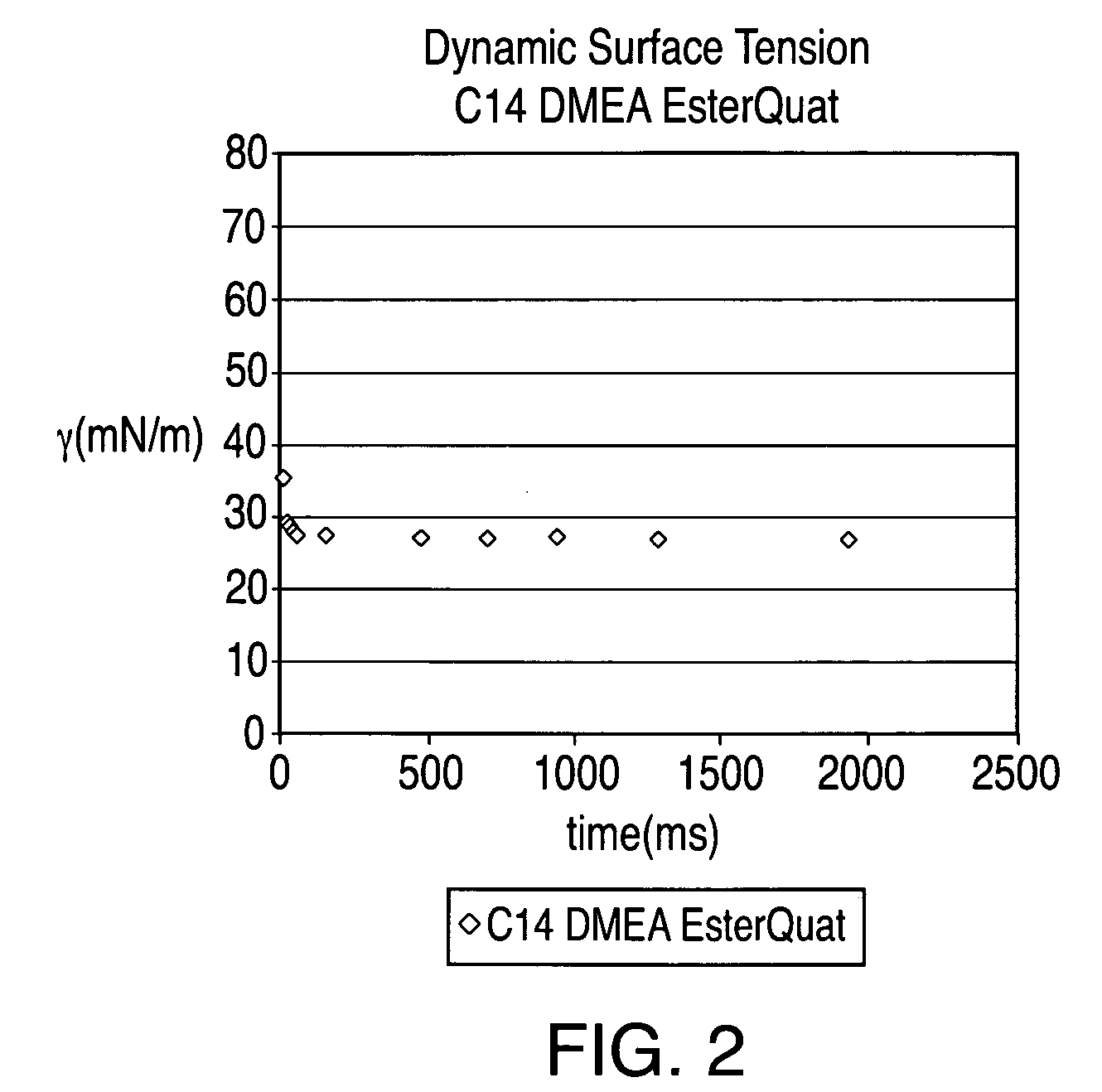Adjuvant and dispersant formulations for pesticidal applications
a technology applied in the field of adjuvants and dispersants, can solve the problems of slow response of targeted weeds to herbicidal compositions, unable to provide the desired phytotoxicity of the formulation for days, sometimes even weeks, and the relative ability of different surfactants to enhance the pesticidal effectiveness of pesticides is highly unpredictable, so as to achieve the effect of enhancing the pesticidal efficacy of pesticides
- Summary
- Abstract
- Description
- Claims
- Application Information
AI Technical Summary
Benefits of technology
Problems solved by technology
Method used
Image
Examples
example 1
Preparation of an Esterquat from Myristic Acid and Dimethyl Ethanolamine
[0088]An esterquat of the present technology was prepared from myristic acid (CH3(CH2)12COOH), dimethyl ethanolamine (DMEA), and MeCl in this example. The esterquat will be referred to as “C14 DMEA MeCl Esterquat.”
[0089]More specifically, about 1753.64 grams of myristic acid and about 1370.61 grams of DMEA were added to a 5 L 4-neck round bottom flask equipped with a mechanical stirrer, nitrogen sparge, a 5-plate Oldershaw column condenser with a temperature gauge. This mixture was then heated to about 140° C. for approximately five hours and the reaction progress was checked via fatty acid titration. The reaction mixture was then heated slowly to about 175° C. to complete the reaction. The resulting product is an esteramine and can be referred to as C14 DMEA Esteramine.
[0090]About 1054.2 grams the C14 DMEA Esteramine and about 529.3 grams of propylene glycol were then added to a 4 L 4-neck pressure vessel equip...
example 2
Preparation of a Comparative Esterquat from Methyl Myristate and Dimethyl Amino Propyl Amine
[0092]A comparative esterquat was prepared from dimethyl amino propyl amine (DMAPA), methyl myristate, and MeCl in this example. The esterquat will be referred to as “C14 DMAPA MeCl Esterquat.”
[0093]About 10.2 grams of DMAPA, about 26.4 grams of C-50 methyl myristate and about 0.388 grams of a 25% solution of sodium methoxide (NaOMe) in methanol (MeOH) were added to a flask equipped with a Dean Stark trap, temperature gauge, and stirring capability. The mixture was heated to 135° C. and then about 5 additional cubic centimeters of methyl myristate was added for fluidization. After approximately four hours the final temperature was about 160° C. and about 5 cubic centimeters of distillate was collected. A small sample was retrieved for analysis by NMR. About 0.010 milligrams of the sample was diluted into about 400 microliters of deuterated chloroform for NMR analysis. The reaction was then de...
example 3
Preparation of a Second Comparative Esterquat from Hydrogenated Coconut Oil and Dimethyl Amino Propyl Amine
[0095]Another comparative esterquat was prepared from dimethyl amino propyl amine
[0096](DMAPA), hydrogenated coconut oil, and DMS in this example. The esterquat will be referred to as “Hydrococo DMAPA DMS Esterquat.”
[0097]About 620.0 grams of hydrogenated coconut oil was added to a 4-liter reactor equipped with a temperature gauge, pressure gauge, and stirring. About 0.31 grams of sodium borohydride (NaBH4) was then added to the reactor. Next, about 615.8 grams of this mixture was charged to a similar flask described in Example 2, with the addition of about 2.1 grams of additional hydrogenated coconut oil. About 283.7 grams of DMAPA was added to this mixture, and then the reaction mixture was heated and the temperature and pressure were monitored. The reaction mixture was heated to about 165° C. at a pressure of about 14 psi. The reaction was allowed to stir overnight. The reac...
PUM
| Property | Measurement | Unit |
|---|---|---|
| cloud point | aaaaa | aaaaa |
| cloud point | aaaaa | aaaaa |
| weight percent | aaaaa | aaaaa |
Abstract
Description
Claims
Application Information
 Login to View More
Login to View More - R&D
- Intellectual Property
- Life Sciences
- Materials
- Tech Scout
- Unparalleled Data Quality
- Higher Quality Content
- 60% Fewer Hallucinations
Browse by: Latest US Patents, China's latest patents, Technical Efficacy Thesaurus, Application Domain, Technology Topic, Popular Technical Reports.
© 2025 PatSnap. All rights reserved.Legal|Privacy policy|Modern Slavery Act Transparency Statement|Sitemap|About US| Contact US: help@patsnap.com



